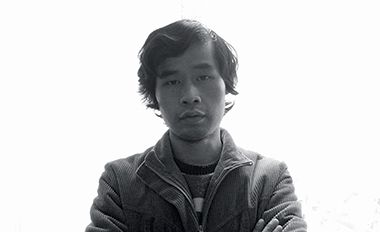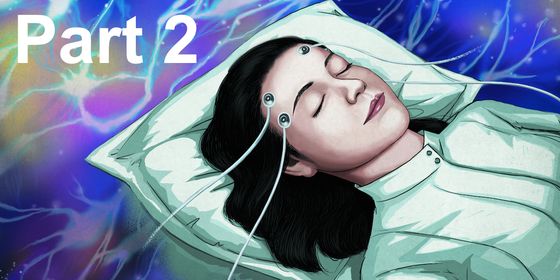A journey through the sky and the mind, part 1
He let his head hang. That way he could better consider certain things. He could see the skin below his chest and a large section of shining white floor. The brightness did all it could not to draw any attention, but it still stirred an anxiety within him. He noticed his skin had formed excessive slack, as if in that instant he had aged ten years—a direct reaction to the bright rays.
He entered the inner room, abandoning the brightness behind him. He knew that, with each step he took, the glow would fade by a degree, until all that remained was darkness. Far in the interior of the room, heavy flannel curtains blocked out all the rays. Clouds of dust floated down and gathered in the corners. This further obstructed the refraction of rays, which would find themselves immobilized, as if bound with rope.
Naturally, the darkest place was inaccessible. The crane standing in the corner of the room held its head high. Its black eyes were profound and serene and following them deeper to the darkness’s last dwelling. For the moment, he could only stand at the exterior of that lodging, peering inside with curiosity and a little greed. The crane flapped its wings. Why it did so was not apparent, but it looked irritated. It had stood there a long time and usually had the patience to adjust to his presence.
But, slowly, it flapped its wings and began to fly around the room. He stood below, somewhat terrified. The crane expanded. It grew so large that the room could no longer tolerate it. The crane’s two wings and head extended out of the walls so that now it was transporting the room on its body as it flew.
He recalled that fantastic event, and thought that perhaps what was happening was that event. In truth, he could not see what was happening outside. The crane’s body barricaded the view. He could only imagine the crane carrying the room on its body as it flew. The crane now engulfed the room. He was buried in dense feathers. Its hot flesh was right above his head. It was, admittedly, an unbearable taste and feeling. He only hoped the crane would land quickly or would swell until the room burst. That way he could fall to the ground amidst a dazzling new field of view.

AUTHOR: Ma Er 马儿
Ma Er lives in Guiling, Guangxi Zhuang Autonomous Region, founder and editor of online literary magazine Shikongliu (《时空流》, Streams of Time and Space). Ma mixes ancient myth with modern imagery and writes with clarity and sophistication. His simple but accurate use of words constructs a world of fable, fantasy, and reality. “Streams of time and space” is also a literary theory proposed originally by Ma—that by studying the past, projecting the future, and ultimately focusing on the present, a writer breaks the rigid boundaries of time and space to achieve a more fluid understanding of the unique characteristics of the era.
Thinking of his room, he was reluctant to let it go. It was a pretty room. Its appeal was not only the beauty of its decor and design, but the outdoors, a splendid piece of scenery. Nowadays, there were few of these stand-alone houses with beautiful views available. In truth, he could not even remember where else he had seen a house exactly like this one: a stand-alone structure facing an open plain with a cluster of mountains in the distance. He could also not remember how he had acquired it—had he bought it? Had he rented it? No recollection surfaced from the ocean of his thoughts. He just knew that every day, from daybreak to nightfall, he had leaned out of that window to gaze at the scenery with nobody coming to bother him. It was as if the surrounding population didn’t exist. He had also never experienced such anxiety—to him, as long as the house and the scenery remained, all would be fine. People were not important.
Now he fretted about where the crane would fly. He knew it had to land someplace. He didn’t know where it would land, or how long it would stay there. He also didn’t know if it would bring the house along when it left again. He concluded his anxiety stemmed from the fear of a new place. He didn’t know what kind of place it would take him to. If he didn’t like the place then it was probable his whole life was lost.
The crane finally let some space into the room. He could put his head out the window to look around. Most of the time he only saw white clouds whooshing by. Sometimes he saw a bird or two brushing passed his window. The crane appeared to have a disdainful disregard for these birds, whose frames and appearance were awkward by comparison. In any case, he didn’t see any signs of agitation. The crane just flapped its wings, silently casting its shadow over the other birds. In an instant, it had flown past them and was rushing into the next layer of clouds.
The crane’s flight patterns were as follows: In the morning and evening it would fly low, as though it was tired or testing the limits of its laziness. Only at noon, when the weather was at its clearest, would it fly to the maximum altitudes. Up high, temperatures were frigid and the air was restless. He mostly huddled up in a corner of the room and shuddered as he looked out the window at the clouds sweeping past. But up high, clouds were actually rather scarce. He mostly had to rely on his instincts to guess what was happening outside—there was an oil lamp on the table, and even though it was securely mounted, the flickering of the flame explained to him the crane’s turbulent path. He mostly watched the prancing flame and imagined the flying crane, its body sloping upward as it climbed and its wings not beating as it glided on a rising current. It only needed to follow the ascending flow; that was all.
…….
You can find part 2 of this amazing story here.












